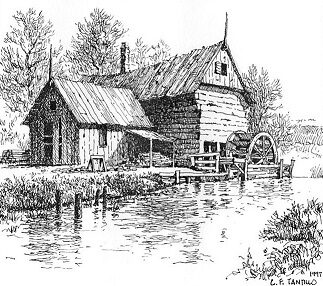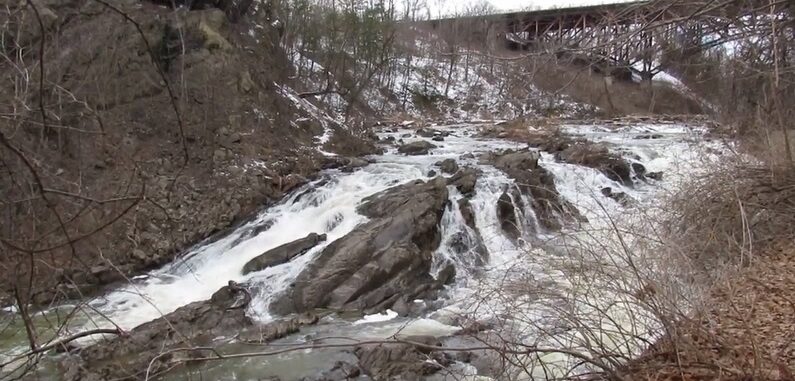WELCOME TO THE BRADT FAMILY ARCHIVE
This website is a collection of the most important and interesting historical documents, letters, books, and articles about the first generation of Bradts in New Netherland. These documents come from the Netherlands, England, New Netherland, and Brazil, but unfortunately none have ever been discovered in Norway.
It will take several months to gather and format all of the records for this website, so come back now and then to see what's new. The site is far from word perfect at this stage, so feel free to ask questions or make suggestions.
The Normanskill Falls in Winter
Albert Andriessen "de Noorman" from Fredrikstad, Norway operated a mill at this site for so many years that the river came to be known as the Norman's Kill (stream). He also leased the surrounding farm.
(For trivia fans, there is a stream in Delaware called the Murder Kill, and New Yorkers are familiar with many kills. "Kill" is the old Dutch word for the English word "gill," a creek, rivulet.)
Organization of this Website
In addition to articles about Albert, his page also features his family members and related topics. Ditto for the Arent page.
If you're not using a pop-up blocker, ads will appear as you change pages. Part of this website builder's income comes from these ads. It's the price of building a free website with them. Otherwise, I think they're a pretty good company and deserve more success.
Connecting the Dots
You can work out a lot about the roots of the Bradt Family just by looking through this website but if you're not familiar with the story, take a look at the article by Ken Bradt farther down on this page. Then browse the Links page to find the Official Website of the Bradt Family Society and other good links.
Some of the family names on this website are spelled in variety of ways. We think of names as having a certain spelling, but that's a fairly recent development. In the 1600s, people spelled their names more or less phonetically and I've followed their lead.
When Bad Genealogy Happens to Good People
or
What Do We Know and How Do We Know It?
As most of you already know, the internet gives armchair genealogists access to gold mines of family history, some of it very well researched, a lot of it not so much. So how can you tell the difference? That's the $64,000 question.
This website was created to provide a showcase for the very best and authoritative documents about the first generation of Bradts in America, the purpose being to highlight what we know and, just as important, what we don't know. And we know a lot, but sometimes not quite as much as the internet would lead us to believe.
For example, we know a lot about Albert Andriessen Bratt, less about his brother Arent, and nothing at all about the lives of their parents, notwithstanding the internet and a few unsupported Family Group Sheets. We know quite a bit about Albert's wife Annetje, and even the baptismal records of their three oldest children still exist in Amsterdam and in Ilfracombe, England.
The Bradt Family has been very fortunate in having several cousins and friends who have been very thorough in researching our roots. What this means is that they go back to "original sources": government records, church records, gravestones, letters, etc. Most of this research has been done in connection with the Bradt Family Society (BFS).
Publications of the BFS are very reliable. While their researchers have made mistakes just like everyone else, they have been very careful and methodical, and they have done it only to have an accurate record. And the result is outstanding! Much of the content of this website comes directly or indirectly from them.
If you'd like more details about any of these documents, please leave a message in the Guestbook and allow a few days for a response. Thank you and happy browsing.

Courtesy of the artist, Leonard Tantillo
This pencil drawing of the Bradt sawmill is purely speculative; there is no actual description of it. The master millwright in the early years was Dutch, so the original mill did not likely have a Scandinavian appearance, at least until Albert took it over. The original, uncropped version of this drawing shows farmland in the background, just as the map on the "Albert" page shows to be true. The undershot water wheel is also true to the setting. Overshot wheels were unfeasible on this stretch of the Norman's kill because they require a dam and a mill pond.
* * * * * * * *
The idea for this website came indirectly from the pandemic. I was noticing that people with spare time on their hands were posting inaccurate family history on-line, information that had been researched and corrected years ago. Even experienced researchers were leaving old information on their websites, inaccuracies that were directly and indirectly misleading many of our cousins. There wasn't a single website that was correcting common mistakes, or assessing unlikelihoods about our Bratt ancestors. This situation would lead to new generations of researchers wading through masses of misleading family history when they could be doing research with real value. The idea for a website that would showcase the most important of what we know, and the most important of what we don't know, suggested itself. If you find this website half as interesting to browse as I found it to build, it was well worth the effort.
ALBERT, ARENT, AND THE BRADT FAMILY
IN NEW NETHERLAND
This article was part of Ken Bradt's invitation letter to the 1987 Bradt Family Reunion. It has been slightly edited with his permission.
It was on August 26, 1636, that Albert Andriesse (Bratt), originally of Fredrikstad, Norway, signed an agreement in Amsterdam, Holland, with the Dutch patroon, Kiliaen van Rensselaer, to come to the New World. On October 8, he and his wife, Annetje Barents, two children, and probably also his brother Arent, set sail from Holland on the "Rensselaerswyck." On November 2, the ship's log records the birth of a third child, in the midst of heavy weather and very high seas. Baptized "Storm" and later known as Storm van der Zee ("Storm from the sea"), his offspring took on "Vanderzee" as their last name.
After some time in port in England to repair the damage caused by the storm, they set out again across the Atlantic, arriving in New Amsterdam (New York) on March 4, 1637. They proceeded up the Hudson River to Rensselaerswyck (Albany), where Albert and his senior partner set about the construction of "two large sawmills" run by a "powerful waterfall." This was on a creek which the Dutch, who referred to the Norwegians as "Noormans," called the "Noormanskill" (Norwegian's creek).
Albert, an energetic and sometimes irascible character, soon split with his partners and started growing tobacco (something he apparently learned in Holland). Several years later he assumed sole responsibility for the sawmills, acquired property on Manhattan Island, and developed a close business relationship with one of his former partners. Van Rensselaer frequently had bones to pick with many of his tenants, including Albert. But at the death of Jeremias van Rensselaer, director of Rensselaerswyck and grandson of the first patroon, Albert was invited to the funeral.
In his personal life, Albert prospered, raised a large family, and married two other women after Annetje died (the first being the widow of the third partner in the sawmill). He survived to be cited in his obituary in 1686 as one of the oldest inhabitants of the colony. Still, according to contemporary historian Stefan Bielinski, it took the customary three generations before the Bradt "foreigners" were fully accepted into Dutch Albany society.
Brother Arent, meanwhile, had become one of the founders of Schenectady. (Most of) His offspring survived the French and Indian massacre of 1690, and have played a prominent role in the life of that city ever since. One of them, Jannetje Bradt, gave birth to a future governor of New York, Joseph C. Yates, 1823-25.
...I didn't (know any of this) until a few years ago when I started poking into the family history and corresponding with other Bradts. One of the surprising things I learned is that with only a few exceptions (e.g., the descendants of Morris Bradt who came from Germany in the 1850s), all persons in North America today of the spelling "Bradt", as well as many Bratts, Brotts, Brodts, and Vanderzees, descended from Albert or Arent.
Over the years, the Bradts have occupied every station in life, from the poor house to Who's Who, from pillar of the community to the average Joe. The entrepreneurs among them have headed every type of organization, from the Maytag Corporation, to a biscuit manufacturer, to the corner tavern.
--Ken Bradt
My thanks to Ken for permission to use this. --the webmaster.

